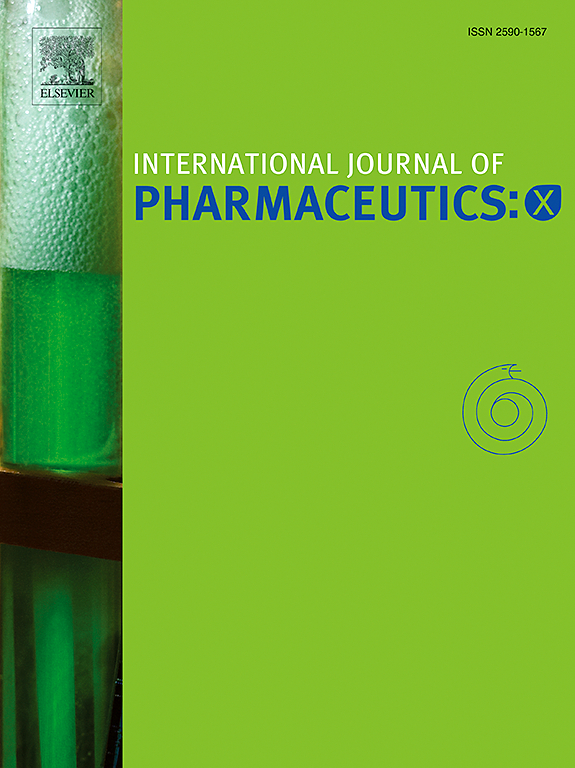Terconazole loaded edge-activated hybrid elastosome for revamped corneal permeation in ocular mycosis: In-vitro characterization, statistical optimization, microbiological assessment, and in-vivo evaluation.
IF 5.2
2区 医学
Q1 PHARMACOLOGY & PHARMACY
引用次数: 0
Abstract
Herein, we investigated the preparation and characterization of Terconazole loaded edge-activated hybrid elastosome (TCN-EHE) adopting thin film hydration technique for the treatment of ocular mycosis. Terconazole (TCN) is a broad spectrum antimycotic agent suffering from sparse aqueous solubility impeding its use in ophthalmic preparations. The scrutinized formulation variables namely X1: Surfactant: Edge activator ratio (SAA: EA), X2: Pluronic® L121 contribution (% of total SAA) and X3: EA concentration (%w/v) were optimized adopting D-optimal design. Ten runs were prepared and characterized regarding their entrapment efficiency, particle size, polydispersity index and zeta potential. An optimized formula was generated, with high desirability, exhibited satisfactory entrapment efficiency, nanoscaled particle size aligning with TEM, plausible zeta potential and bi-phasic release pattern which were not altered after short-term storage. The optimized TCN-EHE displayed 1.94-fold enhanced ex-vivo corneal permeation flux. Safety was ratified through measured corneal hydration level, pH and histopathological evaluation. In-vivo corneal uptake visualized by confocal laser microscopy demonstrated 2.7-fold deeper penetration. Moreover, Superior antifungal activity has been demonstrated displaying 37 % bigger zone of inhibition, 8-fold lower minimum inhibitory and minimum fungal concentration alongside significantly higher biofilm inhibition activity at all tested concentrations for the optimized TCN-EHE compared to TCN suspension. Conclusively, we could prospect that TCN-EHE might be a revamped therapeutic alternative for the delivery of poorly soluble antimycotic agents for the combat of ocular mycosis.
Terconazole负载边缘活化杂交弹性体用于改善眼真菌病的角膜渗透:体外表征,统计优化,微生物学评估和体内评估。
本研究采用薄膜水合技术制备了负载Terconazole的边缘活化杂化弹性体(TCN-EHE),并对其进行了表征。特康唑(Terconazole, TCN)是一种广谱抗真菌药物,水溶性较稀,妨碍了其在眼科制剂中的应用。采用d -最优设计对配方变量X1:表面活性剂:边缘活化剂比(SAA: EA)、X2: Pluronic®L121贡献(占总SAA的百分比)和X3: EA浓度(%w/v)进行优化。制备了10种样品,并对其捕集效率、粒径、多分散性指数和zeta电位进行了表征。优选出的最佳配方具有良好的包封效率、纳米级粒径与透射电镜一致、zeta电位合理、短时间贮存不改变双相释放模式等特点。优化后的TCN-EHE的离体角膜渗透通量提高了1.94倍。通过测量角膜水合水平、pH值和组织病理学评估,证实了安全性。共聚焦激光显微镜观察的体内角膜摄取显示深透2.7倍。此外,与TCN悬浮液相比,优化后的TCN- ehe具有优异的抗真菌活性,在所有测试浓度下,其抑制区增大37%,最低抑制和最低真菌浓度降低8倍,同时生物膜抑制活性显著提高。最后,我们可以展望TCN-EHE可能是一种改进的治疗方案,用于输送难溶性抗真菌药物,用于对抗眼部真菌病。
本文章由计算机程序翻译,如有差异,请以英文原文为准。
求助全文
约1分钟内获得全文
求助全文
来源期刊

International Journal of Pharmaceutics: X
Pharmacology, Toxicology and Pharmaceutics-Pharmaceutical Science
CiteScore
6.60
自引率
0.00%
发文量
32
审稿时长
24 days
期刊介绍:
International Journal of Pharmaceutics: X offers authors with high-quality research who want to publish in a gold open access journal the opportunity to make their work immediately, permanently, and freely accessible.
International Journal of Pharmaceutics: X authors will pay an article publishing charge (APC), have a choice of license options, and retain copyright. Please check the APC here. The journal is indexed in SCOPUS, PUBMED, PMC and DOAJ.
The International Journal of Pharmaceutics is the second most cited journal in the "Pharmacy & Pharmacology" category out of 358 journals, being the true home for pharmaceutical scientists concerned with the physical, chemical and biological properties of devices and delivery systems for drugs, vaccines and biologicals, including their design, manufacture and evaluation. This includes evaluation of the properties of drugs, excipients such as surfactants and polymers and novel materials. The journal has special sections on pharmaceutical nanotechnology and personalized medicines, and publishes research papers, reviews, commentaries and letters to the editor as well as special issues.
 求助内容:
求助内容: 应助结果提醒方式:
应助结果提醒方式:


